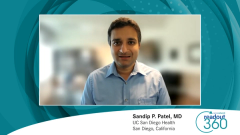
Improving Targeted Therapeutics in NSCLC Management
Before closing out his discussion on NSCLC, Sandip Patel, MD, shares his excitement for evolving targeted strategies and improved patient outcomes.
Episodes in this series

Transcript:
Sandip P. Patel, MD: Many advances in non–small cell lung cancer are making their way into earlier-stage disease, which has the potential for curing more patients. We’ve seen that with the advent of adjuvant immunotherapy from IMpower010, adjuvant atezolizumab after surgery and after chemotherapy; with CheckMate 816, neoadjuvant chemoimmunotherapy with chemotherapy plus nivolumab for 3 cycles before surgery; or after definitive concurrent chemoradiation of the PACIFIC approach with consolidated durvalumab. We’re going to move more agents in the curative-intent setting.
Despite this, there are targetable drivers that we don’t have drugs for. For example, KRAS G12D, KRAS G12V, and various other KRAS mutations. We may have drugs against KRAS G12C, but we don’t for other variances. One potential avenue is targeted therapies for these other targetable driver mutations. Second is the development of novel immunotherapeutics. We’ve seen some recent data with anti-TIGIT antibodies. But what’s going to be the next generation of immunologics that raises the bar for patients who may not get sufficient responses from anti–PD-1 or anti–CTLA-directed approaches? I’m excited to see what the future holds in terms of targeting what’s historically thought to be untargetable—KRAS alleles, as well as novel immune targets that can help more patients and can be more rapidly deployed in the curative-intent setting—so we can secure as many patients as possible.
In non–small cell lung cancer, we’ve seen a revelation in the ability to take care of patients. This is a disease in which a decade ago, in the frontline space, you could have hospice or supportive care as a reasonable control arm in the first- and second-line settings. Now we’re at the point where we have multiple immunologic and targeted therapies. Our ability to deliver these successfully to patients has been so potent that the improvement in mortality in non–small cell lung cancer, which is the most common cancer we fight, has single-handedly reduced overall cancer mortality in the United States. This is because of how common it is but also the potency of these treatments in the metastatic and localized settings. The best is yet to come for our patients. The personalization of treatment options is key. As the diagnostic technologies improve both as more in-depth liquid biopsies and more nuanced tumor investigations, this will help us personalize therapy and make sure patients get the right treatment for their particular cancer.
We’re really moving toward better understanding how we can help those patients who develop resistance to treatment—novel assays and techniques that let us utilize new therapies in a very personalized way to ensure that patients benefit from these treatments if they progress after their best initial attempt. One of the stories in thoracic oncology is that we’ve raised the floor and the ceiling simultaneously. Now we’re looking for new therapies to raise the ceiling higher for the benefit of our patients.
Transcript edited for clarity.
Newsletter
Stay up to date on recent advances in the multidisciplinary approach to cancer.

































































































